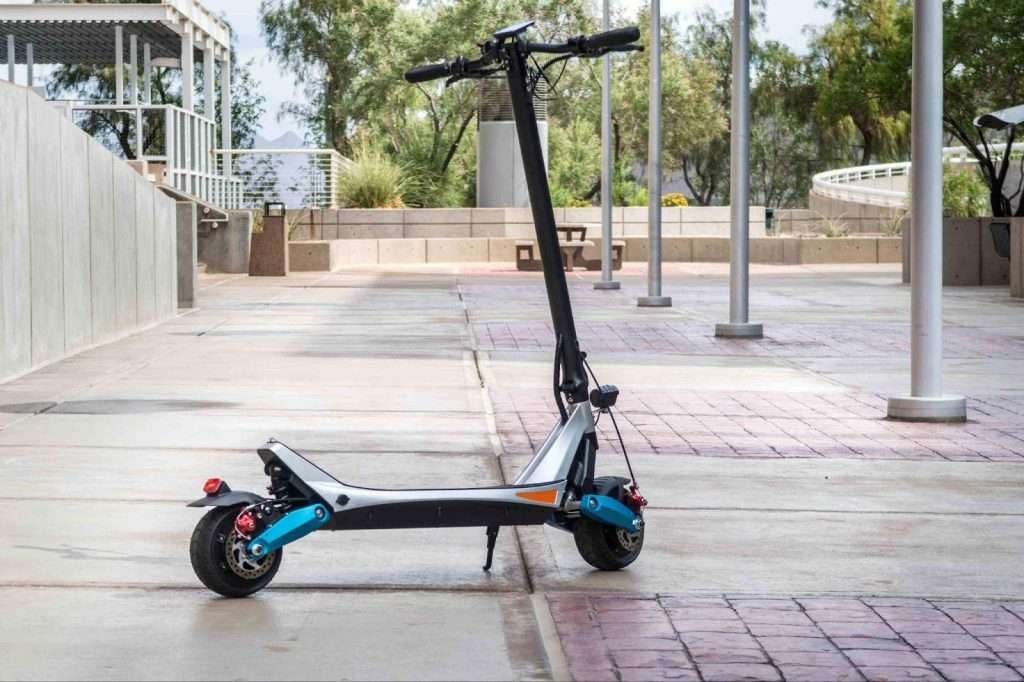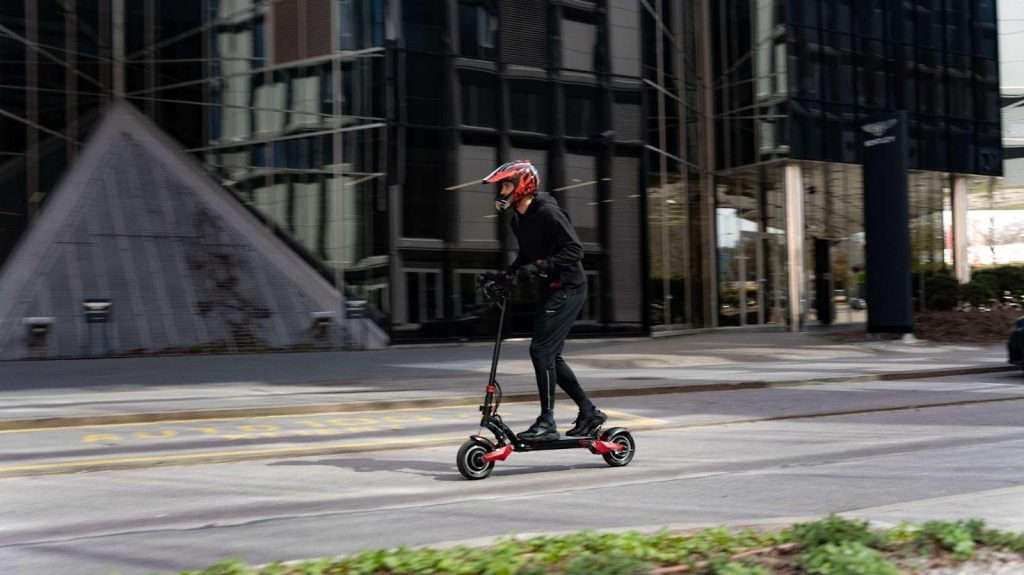As electric scooters continue to gain popularity as a sustainable and efficient mode of transportation, dual-motor electric scooters have emerged as powerful options for riders seeking enhanced performance. There are various types of scooters, like commuter or all-terrain scooters.
At the heart of these high-performance scooters lies the controller, a critical component that orchestrates the operation of the dual motors.

What Does the Controller Do on a Dual motor electric scooter?
What Is An Electric Scooter Controller?
An electric scooter controller is critical in operating a twin-motor electric scooter. It acts as the scooter’s central processing unit, managing and coordinating many operations and systems to guarantee smooth and efficient operation. The controller bridges the user and the scooter’s electrical components, allowing for sufficient speed, acceleration, and brake control.
The electric battery scooter controller typically consists of a microcontroller, sensors, and software algorithms that work together to receive input signals from the rider and convert them into appropriate commands for the scooter’s motors.
It also receives feedback from various sensors, such as the throttle position, brake, and motor speed sensors, to monitor and adjust the commuter scooter’s performance in real time.
Dual Motor Electric Scooter Controller Functions
Motor Control: In a dual motor configuration, the controller controls how much power is distributed among the two engines, ensuring they operate simultaneously to produce the required performance. The controller can manage the battery scooter’s speed and torque by varying the voltage sent to each motor.
Control of speed: The controller is essential for ensuring that the electric scooter travels at the desired pace. Varla motorized scooter offers an impressive 40 mph electric scooter called the Eagle One Dual Motor. It accepts input signals from the throttle and decodes them to calculate the scooter’s appropriate speed.
The scooter may thus smoothly accelerate or decelerate and react to variations in speed input from the user thanks to the controller’s adjustment of the power sent to the motors.
By engaging cruise control, riders can release their thumb, such as on the Varla Eagle One electric scooter with seat, as the controller maintains the desired speed, relieving the rider from continuous throttle input.
Braking Control: The controller is also in charge of the braking system on the dual-motor electric scooter. The controller receives signals from the brake sensor when the rider applies the brakes, whether with a hand lever or foot pedal and starts the required operation.
It may activate the mechanical braking system or switch to regenerative braking, which uses the scooter’s kinetic energy to create electrical power to replenish the battery.
Safety Features: Dual-motor electric scooters frequently have various safety features installed, and the controller is crucial to implementing and managing these features. For example, the controller can have speed limiters to ensure the scooter doesn’t go faster than a specified speed, especially for younger riders or in prohibited regions.
They also have anti-lock braking systems (ABS) to avoid wheel lock-up during harsh or abrupt braking, improving stability and control.
Diagnostic and Monitoring Capabilities: The controller has diagnostic and monitoring features to guarantee the overall performance and health of the electric scooter. It may identify and disclose flaws or systemic concerns through error codes or warning indications, such as battery problems or motor overheating.
This knowledge aids in maintenance and troubleshooting, enabling prompt repairs or replacements.
How Is Controller Power Measured?

There are several techniques for measuring the power of an electric scooter controller. The most frequent ways include monitoring the controller’s Voltage (V) and current (A). For power-related information, refer to the electric scooter’s specs published by the manufacturer.
Voltage (V)
Experts use the voltage of an electric scooter controller to determine its power. Voltage is a unit of measurement for the difference in electric potential in an electrical circuit between two points. It indicates the intensity with which electricity passes through a course. A voltmeter or a multimeter set to voltage measurement mode can measure the voltage.
Current (A)
Measuring the current in amps is another way to determine the controller’s power for an electric scooter. The current measures the pace at which an electric charge flows through a conductor.
The higher the current, the controller can react to signals and inputs from a scooter’s electrical components. The most pronounced effects are the resultant increase in torque, accelerated acceleration, and top speeds.
Use a Multimeter or Look at the Electric Scooter’s Specifications
A multimeter is an invaluable tool for maintaining and troubleshooting electric scooter controllers. With a multimeter, riders can measure voltage, current, and resistance to assess the controller’s performance and associated electrical components.
You can consult the manufacturer’s specs for the electric scooter if you feel you need more confidence taking your voltage or current measurements or if you want to double-check the results. Essential details about the controller, such as the voltage and current ratings, which can calculate its power, are frequently included in the specifications.
When employing this technique, look for the specs in the electric scooter’s user manual or the manufacturer’s website. Look for information on the voltage and current ratings of the controller. These numbers can give a reliable estimate of the controller’s power.
What Are The Different Types Of Dual Motor Electric Scooter Controllers?
Based on the waveform they produce, square wave and sine wave controllers are the two primary categories of twin-motor electric scooter controllers.
Square Wave Controllers: This older and more conventional controller uses square waves. They generate a square wave electrical signal to operate the electric scooter’s motors. These controllers can immediately switch the power on and off, which can rock the passenger back and forth. In general, sine wave controllers are more expensive than square wave controllers.
Nevertheless, they often offer a less smooth and slightly harsher motor control feel. The abrupt changes in the square wave signal may cause less smooth functioning, particularly at low speeds or during acceleration and deceleration.
Sine Wave Controllers: These are a more recent and sophisticated sort of controller. To operate the electric scooter’s motors, they provide a steady and consistent sine wave electrical signal. The smoother, more accurate motor control offered by sine wave controllers produces a more pleasurable, seamless riding experience.
Compared to square wave controllers, they provide more efficiency, less noise and vibration, and better acceleration and torque control.
How to Repair and Maintain Electric Scooter Controllers
Regular maintenance is essential to repair and maintain electric scooter controllers. Hence, this includes keeping the controller clean by removing dirt and debris, inspecting and tightening wiring connections, and looking for visible signs of damage.
It is crucial to seek professional repair assistance as electric scooter controllers are complex electronic devices. By following these steps, owners can prolong the lifespan and maintain the proper functioning of their electric scooter controllers.
When Should You Replace An Electric Scooter Controller?

One should replace the electric scooter controller if it is experiencing persistent malfunctions, shows signs of significant damage, or fails to respond to troubleshooting and repair attempts. Common indicators for replacement include erratic motor behavior, loss of power, inability to control speed or acceleration, or unresponsive input commands.
It is advisable to consult with a qualified technician or follow the manufacturer’s guidelines to determine the need for replacement, ensuring the safety and optimal performance of the commuter scooter.
Summary
In conclusion, the controller in dual-motor electric scooters for adults is a critical component that coordinates the operation of the motors, regulates speed and acceleration, manages braking systems, and ensures rider safety.
With Varla Scooters’ powerful dual hub motors, the controller takes full advantage of the scooter’s capabilities. Overall, the controller plays a crucial role in optimizing the performance and efficiency of dual-motor electric scooters.
The post What Is the Controller Used in Dual Motor Electric Scooters? appeared first on Travel Experta - Travel, Lifestyle, Freedom.
------------------------------------------
By: Marina 'Travel Experta'
Title: What Is the Controller Used in Dual Motor Electric Scooters?
Sourced From: travelexperta.com/what-is-the-controller-used-in-dual-motor-electric-scooters/
Published Date: Sat, 12 Aug 2023 13:48:25 +0000
Did you miss our previous article...
https://consumernewsnetwork.com/travel-news/superyachts-in-thailand-what-to-consider-when-buying-one






